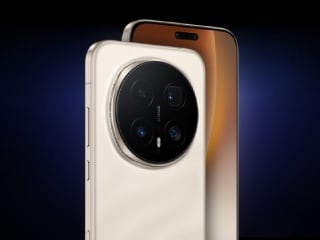- Home
- Mobiles
- Mobiles Reviews
- OnePlus 7 Review
OnePlus 7 Review
The OnePlus 7 is a powerhouse that is priced aggressively in India. But should it be your first choice when looking for a value flagship?

OnePlus 7 sports the same top-of-the-line Qualcomm Snapdragon 855 SoC as the OnePlus 7 Pro
OnePlus has been a disruptor in the smartphone market right since the launch of the OnePlus One. The company has consistently launched powerful smartphones with top-of-the-line hardware at relatively affordable prices. The OnePlus 6 (Review) helped the company break into the premium smartphone segment. It offered a premium design but commanded a higher price than previous OnePlus smartphones. While more expensive than some fans would have liked, the OnePlus 6 still offered great value for money compared to established brands such as Samsung and Apple, helping OnePlus capture a huge portion of the premium smartphone market in India.
OnePlus' six-month upgrade cycle then resulted in the launch of the OnePlus 6T (Review) which managed to further strengthen its position. In addition to premium build quality, it also offered an in-display fingerprint scanner, which wasn't very common at the time of its launch.
With Samsung having now retaken the top spot in the premium smartphone market with the Galaxy S10 (Review) series, OnePlus is using a two-pronged approach by bringing in the OnePlus Pro to compete at the top end of the market, while the OnePlus 7 is intended to maintain the company's hold over the lower-end of the premium smartphone segment.
We have already tested the OnePlus 7 Pro (Review) and we were impressed with the power it packs. The OnePlus 7 boasts of the same core hardware, but is priced much more aggressively at Rs. 32,999. Is this the best smartphone you can get on a mid-range budget right now, or is it worth spending extra for the OnePlus 7 Pro? We put the new OnePlus 7 to the test to find out.
OnePlus 7 design
While the OnePlus 7 Pro gets a pop-up selfie camera and notch-less screen, the OnePlus 7 retains the same design as the OnePlus 6T. OnePlus has given the OnePlus 7 a new paint job to help distinguish it from the older model. It is available in Mirror Gray or Red, and the latter option is limited to India and China markets.
We got the Red colour variant for review, and found it to be a bit too flashy for our liking. We would pick the Mirror Gray option over this. While it is a little disappointing that the design is unchanged, retaining the look of the old OnePlus 6T could be one of the factors that helped OnePlus price its new phone aggressively.
The OnePlus 7 has a glass sandwich design with a rounded metal frame. This makes it comfortable to hold. Unlike the OnePlus 7 Pro, the OnePlus 7's display does not have a curved edges. This is a 6.41-inch Optic AMOLED panel that puts out a full-HD+ resolution (1080x2340) and also has an in-display fingerprint scanner. This is a similar implementation as the OnePlus 6T and uses a CMOS sensor under the display, but the company says it works quicker.
The display has good colour reproduction and gets bright enough when outdoors. You can change the colour profile from Natural to Vivid, or choose between the NTSC, sRGB, and DCI-P3 colour gamuts. An option to tweak the colour balance is also available. This panel doesn't have a 90Hz refresh rate or QHD+ resolution like the OnePlus 7 Pro.
There are thin bezels around the display, though the chin is noticeably bigger. You get the same waterdrop notch at the top as on the OnePlus 6T, which houses the selfie camera. The earpiece sits between the display and the metal frame.
OnePlus has opted for stereo sound output on the OnePlus 7, and the earpiece that acts as a second speaker is considerably longer than on the older model. The bottom-firing speaker is positioned in the left grille at the bottom. We like the positioning since it doesn't get muffled while holding the phone in landscape while playing games. The USB Type-C port is also at the bottom.
![]() The OnePlus 7 has a bottom-firing loudspeaker and a USB Type-C port at the bottom
The OnePlus 7 has a bottom-firing loudspeaker and a USB Type-C port at the bottom
Button placement is identical as on the OnePlus 6T, with the power button and alert slider on the right while the volume buttons are on the left. All buttons offer good clicky feedback. The three-position alert slider is slightly smaller than before, but has a knurled texture that makes it easy to distinguish. It is a handy way to change audio profiles quickly.
A secondary microphone is at the top of the device. Just like the OnePlus 6T, this phone also lacks a 3.5mm headphone jack, and this time you also don't get a Type-C to 3.5mm dongle in the box with the phone. This will be an inconvenience to buyers, and OnePlus should have included one.
The OnePlus 7 has Corning Gorilla Glass on the front and back for protection. It has a glossy finish and our review unit did slide about sometimes. On the rear, there's a dual camera module that is positioned in the centre, along with the dual-LED flash.
This camera module protrudes quite a bit causing the phone to rock about when placed on a flat surface. The back does not pick up smudges very easily, but you might still want to use the bundled plastic case to keep the device safe. OnePlus supplies a 20W fast charger and a USB Type-C cable in the box.
OnePlus 7 specifications and software
Despite being positioned lower than the OnePlus 7 Pro, the OnePlus 7 sports the same top-of-the-line Qualcomm Snapdragon 855 SoC, which is a significant improvement over the outgoing Snapdragon 845. The octa-core Snapdragon 855 is manufactured using a 7nm fabrication process. It has four high-efficiency Kryo 485 Silver cores clocked 1.8GHz, three high-performance Kryo 485 Gold cores clocked at 2.42GHz, and one even faster Kryo 485 Gold core clocked at 2.84GHz. Graphics duties are handled by the integrated Adreno 640 GPU.
The OnePlus 7 is available in two variants, one with 6GB of RAM and 128GB of storage, and the other with 8GB of RAM and 256GB of storage. The Red finish is only available with the more expensive configuration, which is priced at Rs. 37,999. Storage isn't the usual UFS 2.1 that most other smartphones use; this phone gets the new faster UFS 3.0 standard, similar to the OnePlus 7 Pro. So far, the OnePlus 7 siblings are the only phones to launch in India with this new storage standard.
![]() The in-display fingerprint sensor is quick to unlock the OnePlus 7
The in-display fingerprint sensor is quick to unlock the OnePlus 7
Other specifications of the OnePlus 7 include dual-band Wi-Fi 802.11ac, Bluetooth 5, dual 4G VoLTE, five satellite navigation systems, NFC, and the usual sensors.
OxygenOS is as popular as OnePlus, if not more, and adds useful features and customisations to stock Android while retaining most of its essence. The OnePlus 7 ships with OxygenOS 9.5 on top of Android 9 Pie. Our unit was running the March security patch, which is slightly dated.
Most of the features of OxygenOS are carried forward from the OnePlus 6T, though there are a few new touches. This phone has the same Gaming mode that we've seen before, but the new Fnatic mode that is available on the OnePlus 7 Pro is missing here. (Update June 5: The OnePlus 7 has now been updated with the April 2019 security patch and the Fnatic mode after this review was published.)
Android's Digital Wellbeing feature helps you keep tabs on your smartphone usage. OnePlus has gone even further and added a Zen Mode. What this does is disable all of the functions of your phone except for the ability to make and receive emergency calls, and take photos. Once enabled, you cannot switch it off for 20 minutes. It could be a good way to forcibly disconnect yourself from digital distractions.
We have covered the other features of OxygenOS, including Quick Launch, RAM Boost, and a few others, in detail in our OnePlus 7 Pro review.
OnePlus 7 performance, battery life, and cameras
The first thing we noticed about the OnePlus 7 was that it didn't feel as heavy or slippery as the OnePlus 7 Pro. We could use this phone without constantly worrying about dropping it. The OnePlus 7 delivers snappy performance, and no action we performed slowed the Snapdragon 855 down. Given the fact that our unit had 8GB of RAM, we could multitask easily even with apps running in the background.
We found the in-display fingerprint scanner to be quicker than the one on the OnePlus 6T, helping the OnePlus 7 to unlock itself faster. Face recognition is also supported, but its effectiveness depends on ambient light. In the right conditions, it's also quick to unlock the smartphone just by looking in its direction.
![]() The OnePlus 7 is powered by the Qualcomm Snapdragon 855 SoC and has up to 8GB of RAM
The OnePlus 7 is powered by the Qualcomm Snapdragon 855 SoC and has up to 8GB of RAM
We were happy with the AMOLED panel on the OnePlus 7, and the stereo speakers help improve the overall experience when watching videos and playing games. Both speakers can get loud and the output quality is close to what the Pixel 3 (Review) devices put out. Dolby Atmos is also supported, and lets you choose between different audio profiles.
After running our usual benchmark tests, we weren't surprised to see that the OnePlus 7 managed to score very well. In AnTuTu, the 7 managed to clock 375,219 points. It scored 3,536 and 11,192 in Geekbench 4's single-core and multi-core tests respectively.
In GFXBench's Car Chase test, the OnePlus 7 managed 37fps, putting it right behind the Samsung Galaxy S10 trio. It also managed to clock 60,146 points in Ice Storm Unlimited. Thanks to its powerful processor, the OnePlus 7 can play any current-day game you load up. We played PUBG Mobile, Brawl Stars, and Asphalt 9: Legends. PUBG Mobile ran smoothly at the High preset without any hint of lag. We played it for 30 minutes and found that the phone got slightly warm to the touch, but it didn't become uncomfortable at any point.
The battery capacity on the OnePlus 7 is unchanged compared to that of the OnePlus 6T, at 3700mAh. OnePlus has bundled the same 20W charger in the box, but has dropped the Dash Charge branding. In our HD video loop test, the phone managed to go on for 15 hours and 16 minutes. This is better than the time clocked by the OnePlus 6T, possibly due to the more power efficient processor.
With our usage, which consisted of an active WhatsApp account, running a couple of benchmarks, taking camera samples and playing games, the phone managed to still have 30 percent of its power left at the end of 24 hours.
Charging the battery is quick with the supplied 20W charger. It could take the device up to 52 percent in 30 minutes, and 93 percent in an hour. The supplied charger can top the phone up completely in one hour and 16 minutes.
OnePlus has opted for a dual camera setup on the OnePlus 7, compared to the triple camera setup on the OnePlus 7 Pro. It gets a 48-megapixel Sony IMX586 primary sensor with an f/1.7 aperture, PDAF, and Optical Image Stabilisation (OIS). This sensor has a 0.8-micron pixel size but the company claims a 1.6-micron pixel size due to 4-in-1 pixel binning. The secondary sensor is a 5-megapixel depth sensor with an f/2.4 aperture, which kicks into action in portrait mode. At the front, this phone has a 16-megapixel sensor with an f/2.0 aperture.
When taking shots in the default Photos mode, the camera oversamples the 48-megapixel sensor output to return a 12-megapixel picture. You can take photos at the native resolution using the Pro mode on the camera if you want to.
![]()
![]()
![]()
![]() Tap to see full-sized OnePlus 7 camera samples
Tap to see full-sized OnePlus 7 camera samples
In daylight, the OnePlus 7 captured decent details but colours looked slightly muted. Objects at a distance had decent detail and text was legible. Unlike the OnePlus 7 Pro, the OnePlus 7 lacks laser autofocus, but it still managed to lock focus and exposure quickly. If the lighting is harsh, the phone enables HDR automatically.
When taking macro shots during the day, the phone was quick to lock focus. Photos had decent details, but colours weren't accurate. When photographing flowers, we noticed that the smartphone boosted colours, causing them to look artificial. This also resulted in a slight loss in detail. In low light, the phone would take slightly longer to lock focus we felt that we needed to take a second shot in some cases.
In portrait mode, the edge detection was acceptable, but our subjects weren't always sharp. When taking portrait shots in a bright environment, we noticed that the phone would take the frame average and set the exposure, despite us tapping on the subject to meter the face correctly. This resulted in the subject's face being slightly underexposed.
![]() Low-light shot captured using OnePlus 7 (Tap to see full-sized image)
Low-light shot captured using OnePlus 7 (Tap to see full-sized image)
![]() Low-light shot with Nightscape mode on OnePlus 7 (Tap to see full-sized image)
Low-light shot with Nightscape mode on OnePlus 7 (Tap to see full-sized image)
Landscape shots taken in low light had little noise and good details. Switching to the Nightscape mode helped in getting a brighter image overall. We had to tap the screen at times to get the OnePlus 7 to focus where we wanted it to. Noise was handled well in night shots, but you can easily spot grain on zooming in.
![]() Low-light selfie with screen flash (Tap to see full-sized image)
Low-light selfie with screen flash (Tap to see full-sized image)
Selfies were decent, but lacked the level of detail we were expecting. In low light, selfies taken with the screen flash had a lot of artifacting. Shots taken with a light source nearby fared better.
Video recording maxes out at 4K 60fps for the primary sensor. There is a 5-minute recording limit when shooting at this resolution, and a 10-minute limit when shooting at 4K 30fps. When recording footage at 1080p, we found that it was very well stabilised. However, recording at 4K resulted in oversaturated colours. Footage taken recorded at 1080p in low light had a shimmer effect, which was clearly noticeable. Slow-motion video recording at 1080p at 240fps, or 720p at 480fps is also available on the OnePlus 7.
Verdict
While the OnePlus 7 Pro was specced to take on current-gen flagships, the OnePlus 7 is designed to help the company retain its position in the low-cost flagship space. What we like about the OnePlus 7, apart from its aggressive price, is its hardware. The AMOLED display is quite good, and when used in conjunction with this phone's stereo speakers, it does offer a good media experience.
The Qualcomm Snapdragon 855 processor is powerful enough to take on anything you throw its way. That, plus 6GB or 8GB of RAM, and the super fast UFS 3.0 storage standard, makes the OnePlus 7 very snappy. OxygenOS is also great, as it has plenty of handy features and customisation options.
The battery life of the OnePlus 7 was another highlight in our testing. This smartphone can last beyond a day while delivering top-class performance. Unfortunately, camera quality is where the OnePlus 7 still needs some work, stopping it from being a complete all-rounder.
Since the OnePlus 7 is one of very few smartphones using the Snapdragon 855 in India at the moment, it does not have a lot of competition to deal with. If you don't care very much about camera performance, the OnePlus 7 is well worth considering for its asking price. However, with the launch of the Asus ZenFone 6 and the Redmi K20 Pro lined up, you might want to wait a little while to see what these upcoming phones have to offer.
Get your daily dose of tech news, reviews, and insights, in under 80 characters on Gadgets 360 Turbo. Connect with fellow tech lovers on our Forum. Follow us on X, Facebook, WhatsApp, Threads and Google News for instant updates. Catch all the action on our YouTube channel.
Related Stories
- Samsung Galaxy Unpacked 2025
- ChatGPT
- Redmi Note 14 Pro+
- iPhone 16
- Apple Vision Pro
- Oneplus 12
- OnePlus Nord CE 3 Lite 5G
- iPhone 13
- Xiaomi 14 Pro
- Oppo Find N3
- Tecno Spark Go (2023)
- Realme V30
- Best Phones Under 25000
- Samsung Galaxy S24 Series
- Cryptocurrency
- iQoo 12
- Samsung Galaxy S24 Ultra
- Giottus
- Samsung Galaxy Z Flip 5
- Apple 'Scary Fast'
- Housefull 5
- GoPro Hero 12 Black Review
- Invincible Season 2
- JioGlass
- HD Ready TV
- Laptop Under 50000
- Smartwatch Under 10000
- Latest Mobile Phones
- Compare Phones
- Honor Win RT
- Honor Win
- Xiaomi 17 Ultra Leica Edition
- Xiaomi 17 Ultra
- Huawei Nova 15
- Huawei Nova 15 Pro
- Huawei Nova 15 Ultra
- OnePlus 15R
- Asus ProArt P16
- MacBook Pro 14-inch (M5, 2025)
- OPPO Pad Air 5
- Huawei MatePad 11.5 (2026)
- Xiaomi Watch 5
- Huawei Watch 10th Anniversary Edition
- Acerpure Nitro Z Series 100-inch QLED TV
- Samsung 43 Inch LED Ultra HD (4K) Smart TV (UA43UE81AFULXL)
- Asus ROG Ally
- Nintendo Switch Lite
- Haier 1.6 Ton 5 Star Inverter Split AC (HSU19G-MZAID5BN-INV)
- Haier 1.6 Ton 5 Star Inverter Split AC (HSU19G-MZAIM5BN-INV)


















